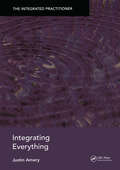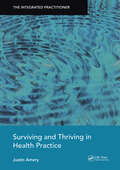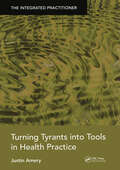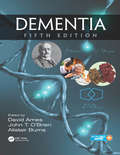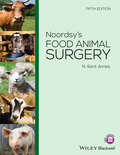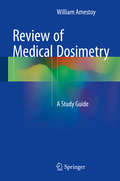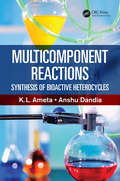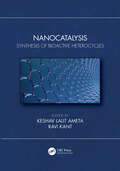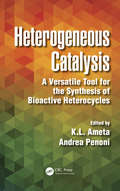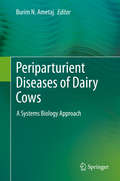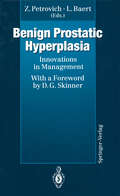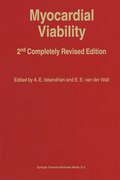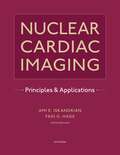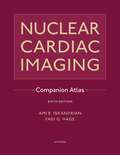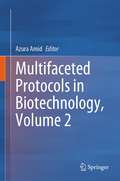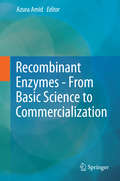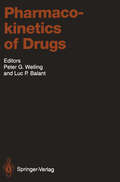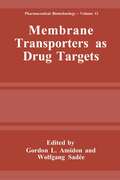- Table View
- List View
Integrating Everything: The Integrated Practitioner
by Justin Amery'Health practice has always been many things, with many constraints and pressures. These things have changed over time and still vary from place to place. Being a practitioner here and now is, from one perspective, no different to the way it has always been. It involves integration. It involves weaving together many threads into one whole tapestry. It involves taking a constrained and limited palate and painting freely. It may be a science, it may be technical, it may be psychological, it may be spiritual, but it is always an art, because it integrates everything in order to create. And what we create is better health.' Justin Amery This extraordinary new series fills a void in practitioner development and well-being. The books take a reflective step back from the tick-box, target-driven and increasingly regulated world of 21st century health practice; and invite us to revisit what health and health practice actually are. Building carefully on the science and philosophy of health, each book addresses the messy, complex and often chaotic world of real-life health practice and offers an ancient but now almost revolutionary understanding for students and experienced practitioners alike: that health practice is a fundamentally creative and compassionate activity. The series as a whole helps practitioners to redefine and recreate their daily practice in ways that are healthier for both patients and practitioners. The books provide a welcome antidote to demoralisation and burn-out amongst practitioners, reversing cynicism and reviving our feeling of pride in, and our understanding of, health practice. By observing practice life through different lenses, they encourage the development of efficiency, effectiveness and, above all, satisfaction. The fourth book in the series, The Integrated Practitioner: Integrating Everything, considers the 'we', the 'me' and the 'other' perspectives of books 1-3 and integrates everything into 'health practice' as a single entity. It recognises the multifaceted nature of healthcare, its different constraints and varied pressures, but also views it from a new perspective, fostering a happier, healthier and more skilful whole within the real-life, complex and often messy world of health practice. Brilliantly written, practitioners, students and trainees and GP trainers will find the enlightening, witty, conversational style a joy to read.
Integrating Everything: The Integrated Practitioner (The\integrated Practitioner Ser.)
by Justin Amery'Health practice has always been many things, with many constraints and pressures. These things have changed over time and still vary from place to place. Being a practitioner here and now is, from one perspective, no different to the way it has always been. It involves integration. It involves weaving together many threads into one whole tapestry. It involves taking a constrained and limited palate and painting freely. It may be a science, it may be technical, it may be psychological, it may be spiritual, but it is always an art, because it integrates everything in order to create. And what we create is better health.' Justin Amery This extraordinary new series fills a void in practitioner development and well-being. The books take a reflective step back from the tick-box, target-driven and increasingly regulated world of 21st century health practice; and invite us to revisit what health and health practice actually are. Building carefully on the science and philosophy of health, each book addresses the messy, complex and often chaotic world of real-life health practice and offers an ancient but now almost revolutionary understanding for students and experienced practitioners alike: that health practice is a fundamentally creative and compassionate activity. The series as a whole helps practitioners to redefine and recreate their daily practice in ways that are healthier for both patients and practitioners. The books provide a welcome antidote to demoralisation and burn-out amongst practitioners, reversing cynicism and reviving our feeling of pride in, and our understanding of, health practice. By observing practice life through different lenses, they encourage the development of efficiency, effectiveness and, above all, satisfaction. The fourth book in the series, The Integrated Practitioner: Integrating Everything, considers the 'we', the 'me' and the 'other' perspectives of books 1-3 and integrates everything into 'health practice' as a single entity. It recognises the multifaceted nature of healthcare, its different constraints and varied pressures, but also views it from a new perspective, fostering a happier, healthier and more skilful whole within the real-life, complex and often messy world of health practice. Brilliantly written, practitioners, students and trainees and GP trainers will find the enlightening, witty, conversational style a joy to read.
Surviving and Thriving in Health Practice: The Integrated Practitioner
by Justin AmeryThis extraordinary new series fills a void in practitioner development and well-being. The books take a reflective step back from the tick-box, target-driven and increasingly regulated world of 21st century health practice; and invite us to revisit what health and health practice actually are. Building carefully on the science and philosophy of health, each book addresses the messy, complex and often chaotic world of real-life health practice and offers an ancient but now almost revolutionary understanding for students and experienced practitioners alike: that health practice is a fundamentally creative and compassionate activity. The series as a whole helps practitioners to redefine and recreate their daily practice in ways that are healthier for both patients and practitioners. The books provide a welcome antidote to demoralisation and burn-out amongst practitioners, reversing cynicism and reviving our feeling of pride in, and our understanding of, health practice. By observing practice life through different lenses, they encourage the development of efficiency, effectiveness and, above all, satisfaction. The first book in this series, The Integrated Practitioner: Surviving and Thriving in Health Practice, encourages practitioners to consider the importance of their personal position as the foundation of health practice. It inspires practitioners to consider themselves as their own most important tool', encouraging them to take better care of themselves, and provides numerous opportunities for reflection through case studies and activities.
Surviving and Thriving in Health Practice: The Integrated Practitioner
by Justin AmeryThis extraordinary new series fills a void in practitioner development and well-being. The books take a reflective step back from the tick-box, target-driven and increasingly regulated world of 21st century health practice; and invite us to revisit what health and health practice actually are. Building carefully on the science and philosophy of health, each book addresses the messy, complex and often chaotic world of real-life health practice and offers an ancient but now almost revolutionary understanding for students and experienced practitioners alike: that health practice is a fundamentally creative and compassionate activity. The series as a whole helps practitioners to redefine and recreate their daily practice in ways that are healthier for both patients and practitioners. The books provide a welcome antidote to demoralisation and burn-out amongst practitioners, reversing cynicism and reviving our feeling of pride in, and our understanding of, health practice. By observing practice life through different lenses, they encourage the development of efficiency, effectiveness and, above all, satisfaction. The first book in this series, The Integrated Practitioner: Surviving and Thriving in Health Practice, encourages practitioners to consider the importance of their personal position as the foundation of health practice. It inspires practitioners to consider themselves as their own most important tool', encouraging them to take better care of themselves, and provides numerous opportunities for reflection through case studies and activities.
Turning Tyrants into Tools in Health Practice: The Integrated Practitioner
by Justin Amery'In order to provide integrated healthcare, we need to integrate a huge number of...entities. Each one of these entities can be a useful tool for our practice. To be effective practitioners, we hope to gain some mastery of them. But sometimes we feel as if they have mastery of us. There are days when we feel on top of our game, we keep to time, we know instantly what's wrong, the right treatment is immediately to hand, our colleagues are supportive and helpful, and birdsong drifts through our open summer window. Then there are the other days...' Justin Amery This extraordinary new series fills a void in practitioner development and well-being. The books take a reflective step back from the tick-box, target-driven and increasingly regulated world of 21st century health practice; and invite us to revisit what health and health practice actually are. Building carefully on the science and philosophy of health, each book addresses the messy, complex and often chaotic world of real-life health practice and offers an ancient but now almost revolutionary understanding for students and experienced practitioners alike: that health practice is a fundamentally creative and compassionate activity. The series as a whole helps practitioners to redefine and recreate their daily practice, in ways that are healthier for both patients and practitioners. The books provide a welcome antidote to demoralisation and burn-out amongst practitioners, reversing cynicism and reviving our feeling of pride in, and our understanding of, health practice. By observing practice life through different lenses, they encourage the development of efficiency, effectiveness and, above all, satisfaction. The third book in the series, The Integrated Practitioner: Turning Tyrants into Tools in Health Practice explores the relationship between practitioners and their tangible, external tools such as time, computers, money, information, colleagues, equipment, targets and office spaces, along with less tangible elements like knowledge, understanding, language, values and beliefs. These tools can be of great benefit when fully integrated and balanced but they often end up controlling practitioners, dictating the manner in which the practice operates and ultimately reducing efficacy. It suggests ways for practitioners to harness the positive forces of these tools and regain control. Brilliantly written, practitioners, students and trainees and GP trainers will find the enlightening, witty, conversational style a joy to read.
Turning Tyrants into Tools in Health Practice: The Integrated Practitioner
by Justin Amery'In order to provide integrated healthcare, we need to integrate a huge number of...entities. Each one of these entities can be a useful tool for our practice. To be effective practitioners, we hope to gain some mastery of them. But sometimes we feel as if they have mastery of us. There are days when we feel on top of our game, we keep to time, we know instantly what's wrong, the right treatment is immediately to hand, our colleagues are supportive and helpful, and birdsong drifts through our open summer window. Then there are the other days...' Justin Amery This extraordinary new series fills a void in practitioner development and well-being. The books take a reflective step back from the tick-box, target-driven and increasingly regulated world of 21st century health practice; and invite us to revisit what health and health practice actually are. Building carefully on the science and philosophy of health, each book addresses the messy, complex and often chaotic world of real-life health practice and offers an ancient but now almost revolutionary understanding for students and experienced practitioners alike: that health practice is a fundamentally creative and compassionate activity. The series as a whole helps practitioners to redefine and recreate their daily practice, in ways that are healthier for both patients and practitioners. The books provide a welcome antidote to demoralisation and burn-out amongst practitioners, reversing cynicism and reviving our feeling of pride in, and our understanding of, health practice. By observing practice life through different lenses, they encourage the development of efficiency, effectiveness and, above all, satisfaction. The third book in the series, The Integrated Practitioner: Turning Tyrants into Tools in Health Practice explores the relationship between practitioners and their tangible, external tools such as time, computers, money, information, colleagues, equipment, targets and office spaces, along with less tangible elements like knowledge, understanding, language, values and beliefs. These tools can be of great benefit when fully integrated and balanced but they often end up controlling practitioners, dictating the manner in which the practice operates and ultimately reducing efficacy. It suggests ways for practitioners to harness the positive forces of these tools and regain control. Brilliantly written, practitioners, students and trainees and GP trainers will find the enlightening, witty, conversational style a joy to read.
Dementia
by David Ames John T. O'Brien Alistair BurnsDementia represents a major public health challenge for the world with over 100 million people likely to be affected by 2050. A large body of professionals is active in diagnosing, treating, and caring for people with dementia, and research is expanding. Many of these specialists find it hard to keep up to date in all aspects of dementia. This book helps solve that problem. The new edition has been updated and revised to reflect recent advances in this fast-moving field.
Dementia
by David Ames John T. O'Brien Alistair BurnsDementia represents a major public health challenge for the world with over 100 million people likely to be affected by 2050. A large body of professionals is active in diagnosing, treating, and caring for people with dementia, and research is expanding. Many of these specialists find it hard to keep up to date in all aspects of dementia. This book helps solve that problem. The new edition has been updated and revised to reflect recent advances in this fast-moving field.
Noordsy's Food Animal Surgery
by N. Kent AmesNoordsy’s Food Animal Surgery, Fifth Edition is a fully updated new edition of the classic field manual on surgical techniques in cattle, goats, sheep, and pigs. Designed for easy, fast access in the field, information is presented using a concise outline style with information boxes, tables, drawings, and photographs to highlight and illustrate key points Noordsy’s Food Animal Surgery is an ideal reference for veterinary students and clinicians seeing food animal patients. Beginning with chapters on general surgical considerations, restraint, and anesthesia, the book’s main focus is on step-by-step procedures for specific surgical techniques. The Fifth Edition has been thoroughly updated throughout to provide a current resource, with additional information on welfare, pain management, and anesthesia. Noordsy’s Food Animal Surgery is an essential purchase for practitioners and students wanting to develop or refresh their surgical skills.
Noordsy's Food Animal Surgery
by N. Kent AmesNoordsy’s Food Animal Surgery, Fifth Edition is a fully updated new edition of the classic field manual on surgical techniques in cattle, goats, sheep, and pigs. Designed for easy, fast access in the field, information is presented using a concise outline style with information boxes, tables, drawings, and photographs to highlight and illustrate key points Noordsy’s Food Animal Surgery is an ideal reference for veterinary students and clinicians seeing food animal patients. Beginning with chapters on general surgical considerations, restraint, and anesthesia, the book’s main focus is on step-by-step procedures for specific surgical techniques. The Fifth Edition has been thoroughly updated throughout to provide a current resource, with additional information on welfare, pain management, and anesthesia. Noordsy’s Food Animal Surgery is an essential purchase for practitioners and students wanting to develop or refresh their surgical skills.
Review of Medical Dosimetry: A Study Guide
by William AmestoyThis study guide will be a reliable support and easy-to-use source of information for students in the fields of dosimetry, physics, radiation oncology, and therapy as they progress through the educational levels in preparation for board examinations. The theoretical and practical knowledge gained by students on previous courses or in clinical settings is reinforced by means of almost 1200 questions and accompanying detailed analytical answers.In order to cater for the needs of all students, the questions are arranged according to three levels of difficulty. The level 1 questions are mainly intended for those hoping to pass the Medical Dosimetrist Certification Board (MDCB) exam but will also be beneficial for Medical Physics candidates taking written exams and for Radiation Oncology residents. The level II questions are in general clinically related and will be relevant for any student, while the level III questions are advanced and are especially suitable for American Board of Radiology candidates or those taking equivalent exams elsewhere in the world.The study guide is broken down into different subject areas, with provision of multiple questions and answers on each subject. In addition, the mathematical and physics questions include brief explanations of how the student can solve each problem. At the end of the guide, three practice tests are included with the same number of questions as are found in the MDCB exam. These tests will help students to test their knowledge and improve their test-taking speed.
Multicomponent Reactions: Synthesis of Bioactive Heterocycles
by K. L. Ameta Anshu DandiaThis timely book provides a succinct summary of methods for the synthesis of bioactive heterocycles using a multicomponent reaction (MCR) approach. The majority of pharmaceuticals and biologically active agrochemicals are heterocycles while countless additives and modifiers used in industrial applications are heterocyclic in nature. With the recent introduction of high-throughput biological evaluation, the importance of MCRs for drug discovery has been recognized and considerable efforts have been focused especially on the design and development of multi-component procedures for the generation of various bioactive heterocycles due to their significant therapeutic potential.
Multicomponent Reactions: Synthesis of Bioactive Heterocycles
by K. L. Ameta Anshu DandiaThis timely book provides a succinct summary of methods for the synthesis of bioactive heterocycles using a multicomponent reaction (MCR) approach. The majority of pharmaceuticals and biologically active agrochemicals are heterocycles while countless additives and modifiers used in industrial applications are heterocyclic in nature. With the recent introduction of high-throughput biological evaluation, the importance of MCRs for drug discovery has been recognized and considerable efforts have been focused especially on the design and development of multi-component procedures for the generation of various bioactive heterocycles due to their significant therapeutic potential.
Nanocatalysis: Synthesis of Bioactive Heterocycles
by Keshav Lalit AmetaThe field of nanocatalysis is undergoing rapid development. Nanocatalysis can help in designing catalysts with excellent activity, greater selectivity, and high stability. Their properties can easily be tuned by tailoring the size, shape, and morphology of the particular nanomaterial. Exhibiting both homogeneous and heterogeneous catalytic properties, nanocatalysts allow for rapid and selective chemical transformations, with the benefits of excellent product yield and ease of catalyst separation and recovery. Nanocatalysis: Synthesis of Bioactive Heterocycles reviews the catalytic performance and the synthesis and characterization of nanocatalysts, examining the current state of the art and pointing the way towards new avenues of research specially synthesis of bioactive heterocycles. Top researchers summarize synthetic methodologies for the synthesis of bioactive heterocycles using a nanocatalytic framework. The catalytic performance and the synthesis and characterization of nanocatalysts are reviewed. State of the art methods and new and emerging applications of nanocatalysts in the synthesis of biologically active heterocycles are detailed. Additional features include: Focuses on designing and synthesizing nanocatalysts specifically for the synthesis of different bioactive heterocycles. Demonstrates how nanocatalysis can produce catalysts with excellent activity, greater selectivity, and high stability. Explores tuning catalysts properties by tailoring the size, shape, and morphology of a nanomaterial. Offers the reader insights into the field of nanoscience via nanocatalysis. Nanocatalysis: Synthesis of Bioactive Heterocycles is a must read for researchers in organic chemistry, medicinal chemistry and biochemistry.
Nanocatalysis: Synthesis of Bioactive Heterocycles
by Keshav Lalit Ameta Ravi KantThe field of nanocatalysis is undergoing rapid development. Nanocatalysis can help in designing catalysts with excellent activity, greater selectivity, and high stability. Their properties can easily be tuned by tailoring the size, shape, and morphology of the particular nanomaterial. Exhibiting both homogeneous and heterogeneous catalytic properties, nanocatalysts allow for rapid and selective chemical transformations, with the benefits of excellent product yield and ease of catalyst separation and recovery. Nanocatalysis: Synthesis of Bioactive Heterocycles reviews the catalytic performance and the synthesis and characterization of nanocatalysts, examining the current state of the art and pointing the way towards new avenues of research specially synthesis of bioactive heterocycles. Top researchers summarize synthetic methodologies for the synthesis of bioactive heterocycles using a nanocatalytic framework. The catalytic performance and the synthesis and characterization of nanocatalysts are reviewed. State of the art methods and new and emerging applications of nanocatalysts in the synthesis of biologically active heterocycles are detailed. Additional features include: Focuses on designing and synthesizing nanocatalysts specifically for the synthesis of different bioactive heterocycles. Demonstrates how nanocatalysis can produce catalysts with excellent activity, greater selectivity, and high stability. Explores tuning catalysts properties by tailoring the size, shape, and morphology of a nanomaterial. Offers the reader insights into the field of nanoscience via nanocatalysis. Nanocatalysis: Synthesis of Bioactive Heterocycles is a must read for researchers in organic chemistry, medicinal chemistry and biochemistry.
Heterogeneous Catalysis: A Versatile Tool for the Synthesis of Bioactive Heterocycles
by K.L. Ameta Ph.D. Andrea PenoniFor more than a century, bioactive heterocycles have formed one of the largest areas of research in organic chemistry. They are important from a biological and industrial point of view as well as to the understanding of life processes and efforts to improve the quality of life. Heterogeneous Catalysis: A Versatile Tool for the Synthesis of Bioactiv
Periparturient Diseases of Dairy Cows: A Systems Biology Approach
by Burim N. AmetajThis book summarizes the results achieved so far by application of various biological systems (including genomics, transcriptomics, proteomics, and metabolomics) involved in the pathomechanisms and early diagnosis of periparturient diseases as specific biomarkers of disease in cattle. These emerging technologies help to extensively enhance our understanding of the etiology and pathogenesis of periparturient diseases of transition dairy cows. The book includes a chapter dedicated to ‘omics’ sciences and one that discusses the myths established in animal and veterinary sciences in recent decades and emerging, new paradigms. The diseases discussed include metritis, mastitis, laminitis, ketosis, rumen acidosis, periparturient immunosuppression, gastrointestinal microbiota and their involvement in disease, infertility, fatty liver, milk fever, and retained placenta. This book is intended for academics, veterinarians, animal nutritionists, researchers, and graduate students working in the field of ‘omics sciences’ with a special interest in dairy cattle health.
Benign Prostatic Hyperplasia: Innovations in Management
by F. Ameye K. Anson M. A. Astrahan Luc Baert K. H. Bichler S. D. Boyd L. W. Brady R. C. Bruskewitz P. Dal Cin P. S. Debicki M. Devonec C. M. Dixon J. P. Fendler E. Hoeben P. Joubert J. Keit H. Lepor W. Mattauch G. B. Mieszkalski R. H. Oyen P. Perrin Zbigniew Petrovich M. C. Pike M. Riehmann E. Shapiro B. Stawarz W. L. Strohmaier S. Szmigielski G. Ursin H. Van Berghe H. Vandeursen H. Van Poppel G. Verhoeven G. WatsonThe past 15 years have witnessed a marked increase in attempts to identify safe and effective treatment alternatives to prostatectomy. This book is a review of the current therapeutic efforts in the management of patients with benign prostatic hyperplasia. It is presented by a group of highly regarded basic and clinical scientists with a major interest in prostatic diseases.The information provided in this book is aimed at a wide audience including private practice and academic urologists, research fellows and doctors in postgraduate training, and basic scientists interested in prostatic pathology.
Myocardial Viability (Developments in Cardiovascular Medicine #226)
by Ami E. Iskandrian and Ernst E. van Der WallAMI E. ISKANDRIAN & ERNST E. VAN DER WALL The first edition of this book was published in 1994. Since then important advances have occurred in the field of myocardial viability. This, coupled with increasing interest by the scientific community in the broader issues of its relevance to patient care, suggested to us the need to write the second edition. We are most fortunate to have the help of a distinguished group of experts who have helped shape the field; we appreciate their commitments and contributions. Almost all chapters have been radically modified. Chapter 1 deals with pathophysiology of myocardial hibernation and stunning; Chapter 2 with apoptosis; Chapter 3 with the role of positron emission tomography; Chapters 4 and 5 with the role of single photon emission computed tomography with thallium-201 and technetium agents, respectively; Chapter 6 with the role of SPECT fatty acid imaging; Chapter 7 with the role of SPECT FDG imaging; Chapter 8 with the role of cardiac catheterization angiography; Chapter 9 with the role of echocardiography; Chapter 10 with the role of magnetic resonance imaging; and Chapter 11 with clinical applications. Finally, Chapter 12 provides a short summary.
Nuclear Cardiac Imaging: Principles and Applications
by Ami E. Iskandrian and Fadi G. HageNuclear cardiac imaging refers to cardiac radiological diagnostic techniques performed with the aid of radiopharmaceuticals, which are perfused into the myocardium as markers. These imaging studies provide a wide range of information about the heart, including the contractility of the heart, the amount of blood supply to the heart and whether parts of the heart muscle are alive or dead. This is essential information for cardiologists, and nuclear imaging has become an increasingly important part of the cardiologist's armamentarium. Chapters in Nuclear Cardiac Imaging cover historical, technical and physiological considerations, diagnosis and prognosis, conditions other than Coronary Artery Disease (CAD), advanced cardiac imaging, and challenges and opportunities. New to the sixth edition are key point summaries at the start of each chapter, clinical cases with videos, and a question and answer chapter on practical issues. This volume is ideal for nuclear cardiologists in training and nuclear clinicians alike who are searching for quick answers to important clinical and technical questions.
Nuclear Cardiac Imaging Companion Atlas
by Ami E. Iskandrian and Fadi G. HageA companion to the 6th edition of Nuclear Cardiac Imaging, this text offers readers additional case examples and figures not included in the related textbook as well as a concise option for readers seeking a case book for quick review for examination preparation or assistance with image interpretation. Rather than focusing on theoretical explanations, the atlas provides high-yield, rapid imaging support with a particular emphasis on cases with angiography, echocardiography, and other imaging correlations. With a variety of cases and multiple-choice self-assessment questions along with a comprehensive multiple-choice exam to be taken upon completion of the text, the Companion Atlas will solidify readers' knowledge and ranges in levels of difficulty, including those intended to challenge even the most expert reader.
Multifaceted Protocols in Biotechnology, Volume 2
by Azura AmidThis contributed volume, “Multifaceted Protocols in Biotechnology, Volume 2”, consists of multidisciplinary methods and techniques commonly used in biotechnology studies. There are two sections covered in this book – Ionic Liquid Related Techniques & Evergreen Biotechnology Techniques. A brief introduction supports each protocol to allow easy learning and implementation. The first section consists of three chapters covering studies in modern biotechnology focusing on the role of ionic liquid techniques in extracting secondary metabolites, enzyme stabilization and biomass processing. The second section covers evergreen methodologies. It comprises five chapters covering topics on microcarrier technology for cell culture; Polymerase Chain Reaction for non-halal sources detection in food; ELISA for biomarker identification; gamma ray-induced mutagenesis for enhancing microbial fuel cells; and the effect of temperature on antibacterial activity of Carica papaya seed extract. This book will be useful to graduate students, researchers, academics, and industry practitioners working in the area of biotechnology
Recombinant Enzymes - From Basic Science to Commercialization
by Azura AmidThis edited work presents studies that clarify the basics of producing recombinant enzymes that finally lead to commercialization. It enables researchers to see what is crucial to the commercialization process, from examining the cloning method, using analytical techniques such as calculating the total protein content and enzyme activity, through considering upstream and downstream processes, to the final product.Readers will discover the importance of the cloning method as it influences the upstream and downstream processes and determines the level of success of the recombinant enzyme commercialization processes. We see that the two main factors that are particularly sensitive during the cloning process are the vector and the host.A discussion of analytical techniques is presented followed by studies on important stages during the upstream processes including the process of optimizing the media to get results and high enzyme activity. Downstream processes such as the cell disruption technique, purification and formulation of the final product are then considered. The reader is introduced to software that helps streamline recombinant enzyme production from the upstream to downstream processes, to facilitate the process of up-scaling production.This work includes a case study as tool, to guide understanding of the commercialization process. The work is written for researchers in the field and is especially suited to those who are under pressure to embark on the tough process of commercialization.
Pharmacokinetics of Drugs (Handbook of Experimental Pharmacology #110)
by G. L. Amidon J.P.F. Bai L. P. Balant C. M. Barksdale I. A. Blair D. D. Breimer M. Chiba J. Delforge M. Eichelbaum B. L. Ferraiolo A. J. Fischman M. Gex-Fabry N. Holford J. Kantrowitz H. K. Kroemer T. M. Ludden J. M. Mayer B. Maziere C. McMartin G. Minkus M. A. Mohler G. D. Nordblom R. O'Neill K. S. Pang O. Pelkonen A. Racine-Poon R. H. Rubin J. L. Steimer B. H. Stewart H. W. Strauss B. Testa S. Vozeh P. G. Welling R. G. Wills A. YacobiA compilation of researchers' experience in the areas of bioanalysis, pharmacokinetics, and drug metabolism, to present an up-to-date and comprehensive treatise on the application of these and related technologies in drug discovery, development, and clinical use. Contents cover descriptions of analytical methods, in vitro metabolism technology and membrane transport, reappraisal of classical pharmacokinetic problems, and the time course of drug action. The book concludes with a description of PET and imaging methods in pharmacokinetics and an appendix containing a critical appraisal of computer methods and pharmacokinetic software available for PCs.
Membrane Transporters as Drug Targets (Pharmaceutical Biotechnology #12)
by Gordon L. Amidon Wolfgang SadéeBecause progress in the field of transporters has been extraordinary, this volume will focus on recent advances in our understanding of the structure, function, physiology, and molecular biology of membrane transporters. There will be an emphasis on transporters as molecular targets for drug delivery and disposition in the body.
